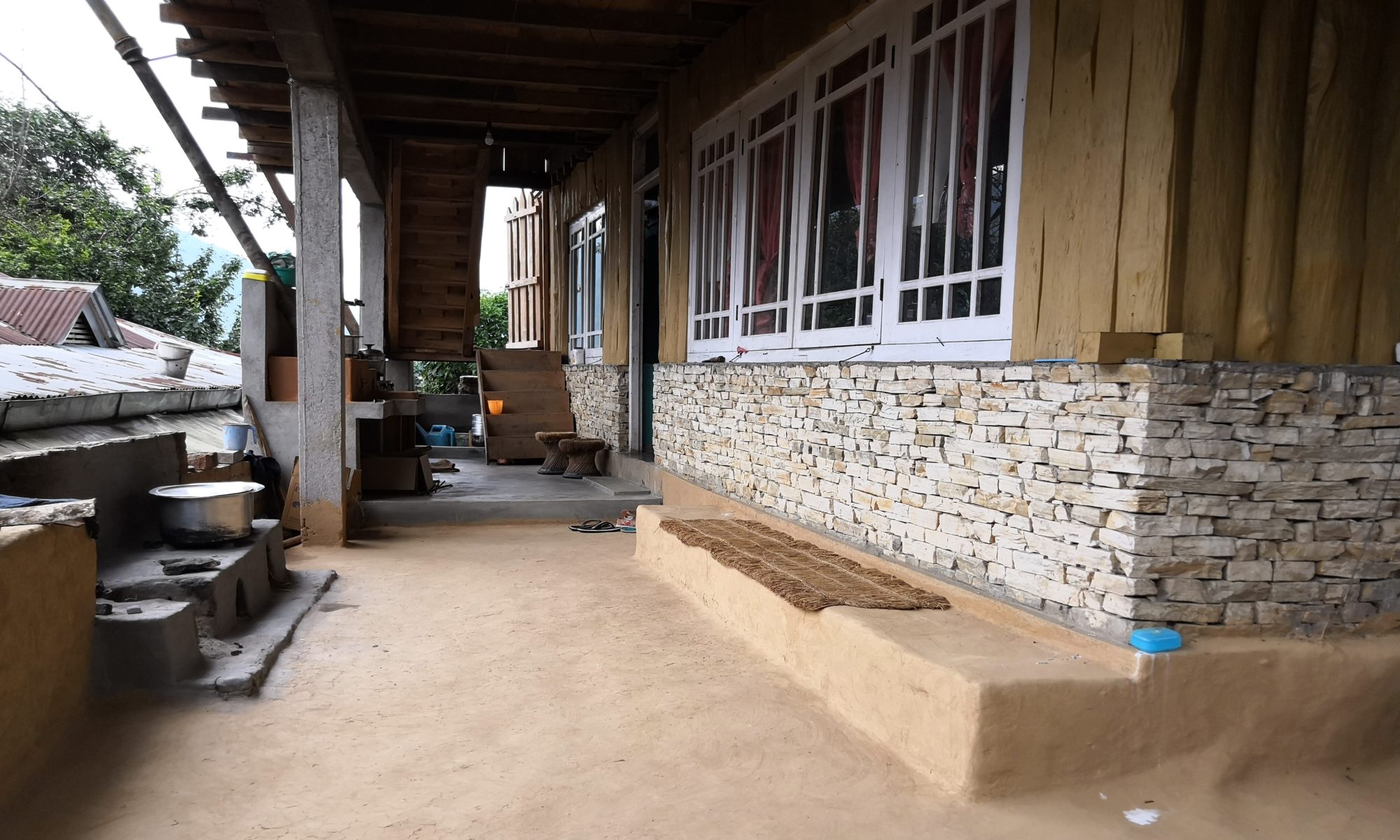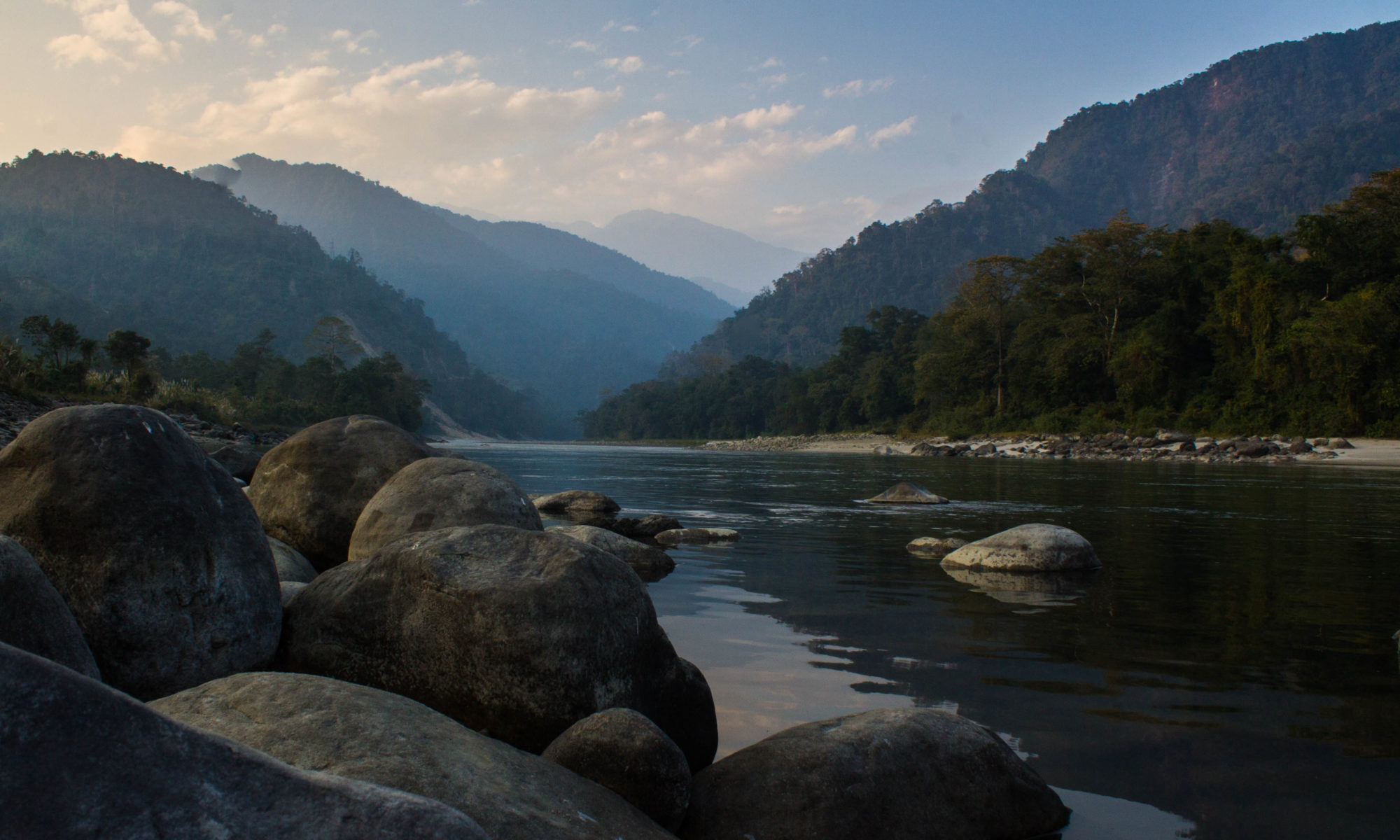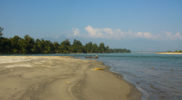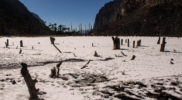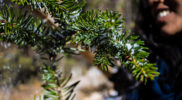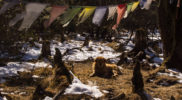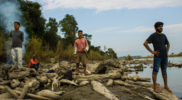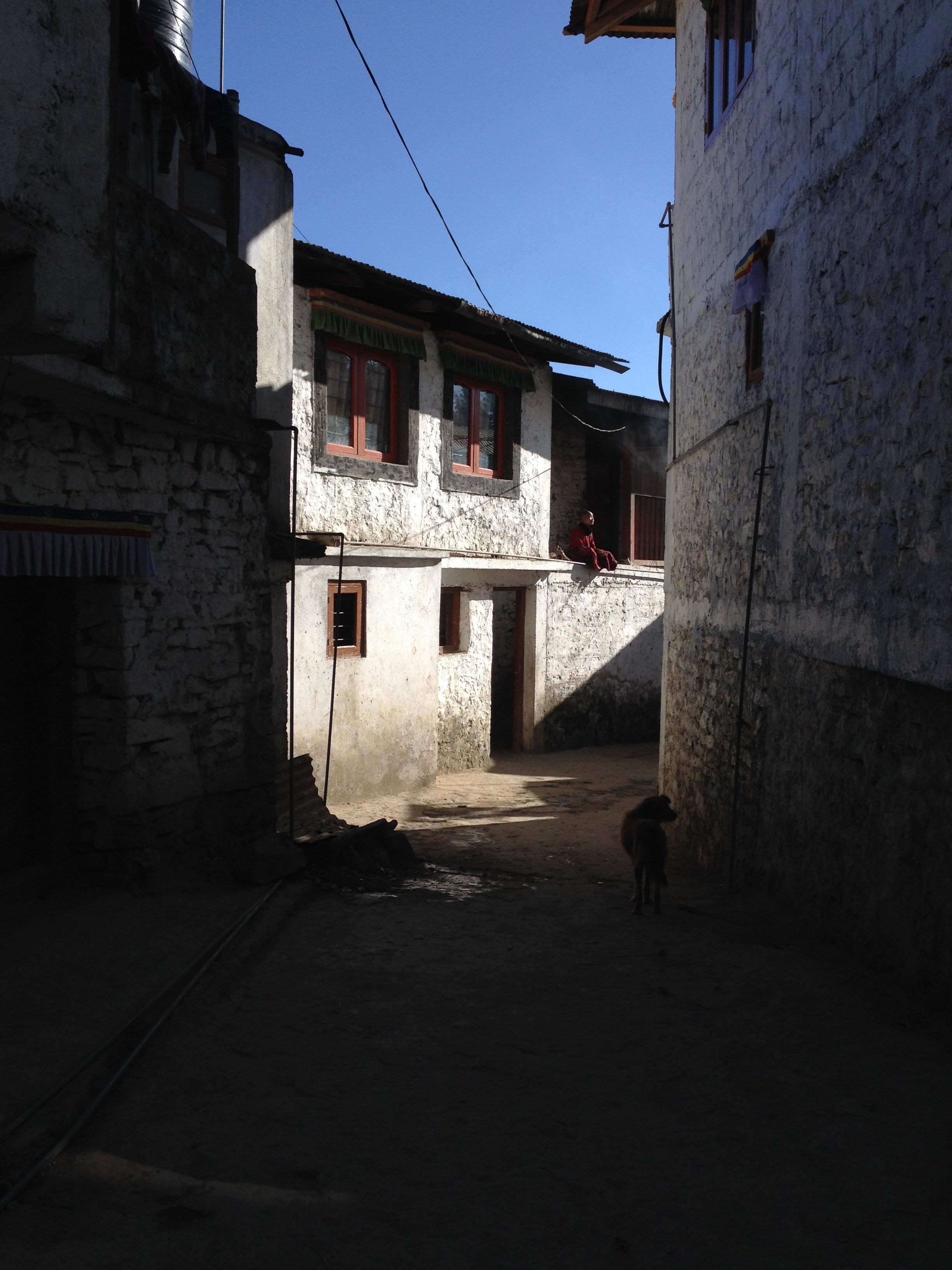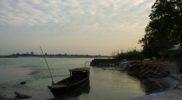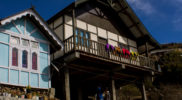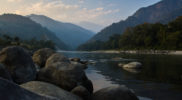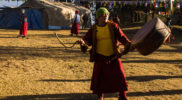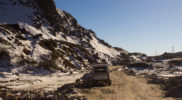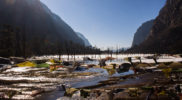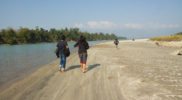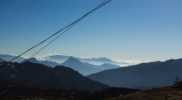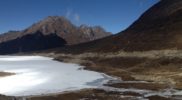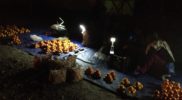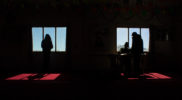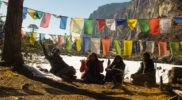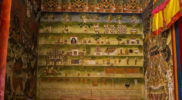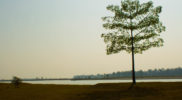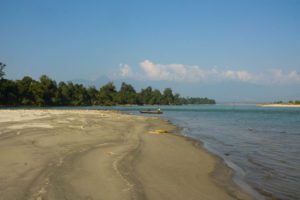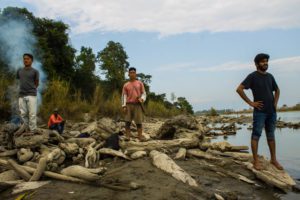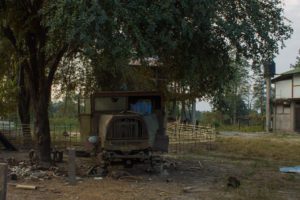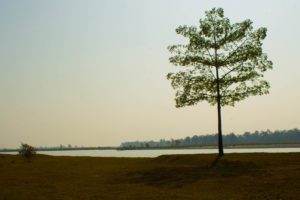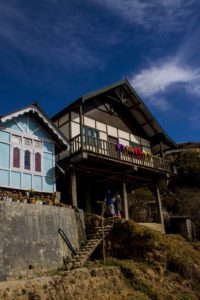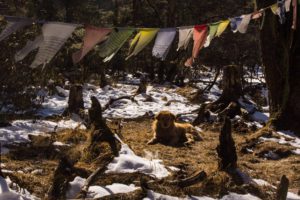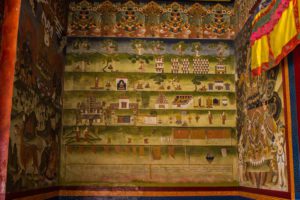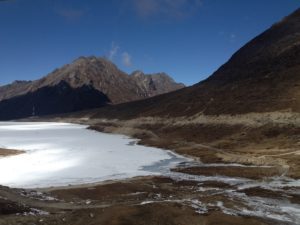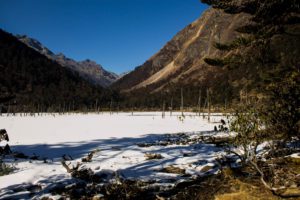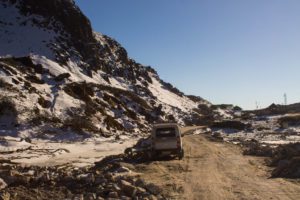Arunachal Pradesh Journal
The adventures of Atul, Divya, Lakshmi and Yogesh in ‘The Land of the Dawn-lit Mountains’
25th December, 2015
Christmas brought with it the promise of new lands and a happy ending for one of the most trying years of my life so far. I can say the same for my co-adventurers, for we had all lost very dear friends to 2015 and struggled through the thick of it to reach this day. We went through bad juries and sad exams with the incentive of Arunachal. But there could not have been a longer train journey to get there.
Anand Vihar Railway Station once again. We went to Benaras that October from this very station. We settled in the train well in time, rucksacks stuffed to the rim, all geared up with sleeping bags, winter clothes, dry fruits, the very essential Inner Line Permits, I had my compass in case we got lost, Divya her uncomfortable bulk of photography equipment, and all of us packed truckloads of hope.
The train to Guwahati was to take two days and a night to reach the destination. It was easy to say bye to Delhi, its suburbs, its neighbours, its neighbours’ neighbours and all that grey sky. We had the prospect of better views, our interesting selves and UNO to keep us company through the long ride. We were also equipped with magazines advertising Arunachal Pradesh which we found at Arunachal Bhawan in Delhi, where we had our permits made. As time dragged by we attempted to add some resolution to our flimsy travel plan. We debated pointlessly about where to go, what to do and in which order until night fell, when we gave in to a few more rounds of UNO before resigning into our sleeping bags – great for travelling sleeper class in Indian Railways.
26th December, 2015
Boxing Day. Another day in the train. More useless debating and more UNO. Through farmlands and over rivers. The railway track stretched across an awe-worthy variety of surroundings and weather conditions. It gradually got warmer as we continued our eastward journey, crossed West Bengal and proceeded to Assam – images of Rhinos and indigenous tribes entertained my idle mind. This was already the farthest east that any of us had ventured on Indian lands.
We were closing in on Guwahati Railway Station when we were greeted with dirt balls that struck the window panes; one of which flew through and hit Yogesh. That is probably how children in the nearby slum amused themselves as trains passed by – making mirth out of ambushing unsuspecting passengers staring out windows. Sigh.
When the relentless rumbling of the train did cease conclusively, standing on the platform in the train station did not exactly offer the satisfaction that we had been anticipating. It was dirty and crowded; the outside was more so. Suddenly it didn’t feel like we came far from Delhi. The only things that gave away our location other that the signboards was the accent of the locals and the humidity in the air.
It was already dark and we had yet to hunt for an affordable hotel. As it turned out, people were reluctant to shelter the likes of us even in the arguably shady area of Paltan Bazaar, even in exchange for money. It was probably the unkempt hair, the baggy pyjamas, the hungry faces and the big fat rucksacks – painting us with the image of runaways. No matter how questionable our state, it was unsettling to be turned out of dingy hotels on a noisy market road heading to the railway station. After more collective effort we found ourselves in an agreeable place to spend the night, Hotel Trimurty International. Late-night dinner at KFC was then followed by sound sleep.
27th December, 2015
Guwahati lives up to the image of a thriving metropolis. We beheld exactly what a Sunday morning in a busy Indian city promises – lots of people and lots of activity. In an attempt to experience Guwahati’s local, we sauntered into one of the dhabas by the road, and feasted on what was going to be one of our last satisfying breakfasts in the next few days.
We had an entire day to spare in this city before our night train to Naharlagun. Guwahati had quite a few interesting places to visit, it being a major port on the river Brahmaputra and known for its many temples. However, we stuck to IIT Guwahati so Divya could have her little wish come true – visiting the institute’s design block. So we took a very loud bus that followed a road through the renowned areas of Paltan Bazaar, Pan Bazaar and Kamakhya which were obviously giving in to a mighty wave of urban development with much construction work in progress. We rode along the wide and mighty Brahmaputra, although in a much better state than Delhi’s Yamuna, the river banks clearly needed better upkeep. When we reached a dusty crossroads called Jhalukbari, we switched to a shared auto. To get to the northern banks of the river where the campus was located, we crossed the 1.3 km long Saraighat Bridge which was a rail-cum-road connection between North and South Guwahati. Besides being known for this giant of a structure, Saraighat holds the history of a fight between the Mughals and the Ahoms, who ruled the area from the 13th to 19th century. The Ahoms won by the way.
In the seemingly deserted area outside the campus: how does a group 20ish misfits who look like they belong elsewhere enter an institution (with an intimidating gateway) during the holidays… Not by staring at the guards right in the faces for long enough to plant suspicion, and definitely not by holding a conspicuous hush-hush meeting before walking up to the guard with a lame story. We soon discovered a secondary entrance, with the help of some students and ended up walking around a campus, large and impressive, unlike the kind us SPA students are used to. Not that we complain much about that – it happens to be one of the reasons we continue our exploration of the city of Delhi. If ever we were to be granted such a sprawling campus of that scale with as many lakes or canteens and as much greenery, we would laze around speaking of existential issues. I bet it takes some will power to walk or even take one’s bike outside of the boundary – not that much existed immediately outside. One might not even feel the need to step outside, what with all the hills within the campus beckoning to you, just waiting to be conquered on some pleasant Saturday morning.
Believing that I have established the largeness and the remoteness of this place fairly well, I will now explain the aesthetic of it all – it was very beautiful and peaceful. Criminally so. Were students here even meant to study, or just pass time like we did – sitting by the lake, then sitting on the steps to a large, architecturally pleasing building, then sitting on a bench under a tree, then lying on the grass in the courtyard of the design block admiring the little OAT-ish area, then sitting again to drink hot chocolate at a kiosk (much better equipped than our very own Nescafe), all the while appreciating the comfortable silence. Can one ever tire of aimless musing (while sitting / standing / lying down)…
As evening fell, we began to stroll back to the outside and walked out the very gate, guarded by the same men we had encountered that morning. Sigh. A day well spent, but hardly over. Turned out that we wouldn’t have to return to Jhalukbari to get to Paltan Bazaar. Ferries frequented the other bank at regular intervals, so we took another shared auto through a rural setting to get to the quay just in time for the departure of a smoke belching, and over-crowded vessel. In no time we were crossing the Brahmaputra alongside Kawasakis and Hondas. The level under the deck was brimming with people. We escaped the claustrophobia due to our late arrival and sat on the deck, close to the edge, peering into the dark waters. The sound emerging from the ferry reminded me of the Industrial Revolution. Clouds of smoke added to the vision. Good thing it was dark, we did not get to see the polluted state of the waters even though we felt it.
As we grew nearer to Pan Bazaar the shimmering blobs of lights on the other bank started to take discernible forms. We decided to dine in the market, and by the time we got off the ferry we had zeroed in on a place we discovered on Zomato. Directions from the internet nor directions from people; neither helped us find the place before it shut down. With a train to catch in the night and having expended a considerable amount of time and energy in the fruitless exercise, we made do with the very next diner we laid eyes on.
At 21:00 we boarded the train to Naharlagun, a town in Arunachal about 15km from the capital, Itanagar. Apparently the railway line was recently opened, one could tell from the state of the compartments – very clean and very unlike Indian Railways. Sleep came easy and with every expectation to wake up to a much colder morning.
28th December, 2015
5:30 next morning found us in a railway station that was close to deserted – the other passengers had left in a hurry. The station was a vision in itself, set in a hilly terrain, with the train gazing on to the sky that was erupting into a million shades of pink, heralding the sun rising from behind the hills. There was no platform on the other side of the track, just undulating land and fog. It was cold.
We decided we needed to freshen up at the station while we had access to the waiting rooms, given our uncertain travel plan. On the way out, we made small talk with the soldiers who checked our Inner Line Permits and the shopkeeper who served us tea flavoured with cardamom. You could already tell that people were nicer here.
Outside was a different story. I expected sparse population in Arunachal Pradesh, but we were really in the middle of nowhere. A car, which was the only thing adorning the parking lot, roared into life and whizzed past us four clueless souls. There was a moustached traveller as well who looked just as lost. There wasn’t a soul outside the station (except us of course). We soon discovered that the only bus that carried passengers arriving by the only train (which ran once a week) to this station had already left, while we were twiddling our thumbs in the waiting room. Ta-ta cheap public transport. Also all the expensive cabs were gone. Ta-ta any transport at all.
Turns out we were still in the outskirts of Naharlagun. The Naharlagun Railway Station which opened in 2014 is 7km away from the town itself. Walking there was voted out by majority. When a car (we later learnt to safely assume that most cars that plied the roads in Arunachal are cabs) finally came our way, our friendly seller of tea helped us strike a rather expensive bargain. And so we shared an overloaded and overpriced taxi with the moustached man to the town of Naharlagun.
Through winding and dusty roads we rode. The driver turned out amiable as well and spoke of how the town was transforming into a more “badmaash” version of itself. We also took advice from him regarding our travel route – like from every other person we met since morning. He dropped us off at the bus terminal whose ticket counter was closed. It was still too early for any business to begin. Restaurants didn’t open too, we realised hungrily.
We wound up walking up and down the road which was only just beginning to wake up to its morning activities. The buildings on the sides were mostly new construction, nothing higher than a few floors and old ones were not exactly well kept – like the road. We noticed a lot of posters that warned public against unsafe sex and drug abuse. AIDS and addiction were obviously huge concerns. If one was to look at Delhi as a happily corrupt and polluted old metropolis, Guwahati would present itself as a city aspiring towards that image, and more than half way there. In this light Naharlagun appeared as a town that was cosying up to its vices, like a teenager who going astray.
Breakfast was a disappointment. Not much on the menu for vegetarians, but fried rice and noodles. Not even momos. By the time we reached the bus stop again there was small crowd outside the ticket counter. A black board hanging on top of the window informed us of the buses and their schedules. We settled for Pasighat after arguing out our options. The bus was to take off at noon, so we had a few good hours for exploration before we left. Divya was not feeling up for it, so we left her with the luggage.
The road was now alive and buzzing. There was a noisy marketplace at the far end, which sold a lot of fish and chicken. We turned into a street in search of a stream that we had passed by on our way from the station. More walking lead us through neighbourhoods with small houses and chicken coops, until we found ourselves on a dirt road following trails. There it was – the stream that had summoned us. The path ran alongside it. The water was a caustic yellow close to the banks and a murky brown where the flow was stronger. There were kids playing football in a yard next to a helipad. Women carried children on their backs and hens in their hands.
Now we were walking to a suspended bridge that spanned the stream to get to the other side. On reaching we saw that it was made of wooden planks that hung from ropes. The idea of crossing it was exciting. Probably dangerous too. But then all kinds of people were using it, with little heed being paid to a certain maximum load or any extra attention. We would do it too, albeit not so gracefully. The bridge danced to any irregular movement and presented gaping holes in more than a few places. Despite my obvious distress I crossed it, because what kind of adventurer would I be if I gave in to fear. The boys seemed considerably at ease. Pfft.
The other end gave way to a trail that led us to clear water gushing over stones and pebbles. It was quiet except for the water. Hopping over slippery stones got us deeper into the undergrowth. We sat there for some time before confronting the bridge again. We took the same path on our way back. A helicopter was now taking off from the pad. None of us had witnessed that before – the blades rotated for a long time, until finally it took off like a dragonfly. Up, up, and away.
Divya had made herself comfortable with a book and a bag of chips. She continued reading until we got on the bus. We decided on a light lunch of chips and biscuits, lest the journey upset our tummies. Good decision. The ride was a long one. We were on a National Highway that mostly ran in Assam. Outside the window were lush green fields and traditional houses with large, thickly vegetated yards. Bamboo seemed to be a favoured material for construction.
We rode away from the sunset for 253km before finally reaching Pasighat, our eastern most conquest in India. As the taillights of the bus disappeared down the road, darkness consumed all. It was hardly 19:00 and the townlet had already resigned for the day. Finding a hotel is the boring bit – availability, price, condition & services; any issue – repeat the whole tiring process in a different place. Once settled into Hotel Siang, we walked over to the restaurant next door for dinner. It was about to close but the owner was kind enough to serve us. But lo and behold, only fried rice or noodles in the vegetarian department. This didn’t concern Atul, as he is a meat lover, but rest of us could see ourselves getting thinner by the end of this tour. Dal was a kindness the owner cooked for us that night. We requested him for momos sans meat for the morning after, which he happily acquiesced to.
Before we returned to our beds, we went back to the expensive hotel that we walked out of only an hour ago. The hope was to acquire information about the Daying Ering Wildlife Sanctuary which our reason for visiting Pasighat. The men who attended to our queries knew very little, but they quickly printed out the first page that Google showed. It was completely unnecessary as we were all equipped with smart phones. A moment later they printed out another copy of the same page with a larger font size. I will never get over how nice people are here.
29th December, 2015
Waking up to the promise of momos was easy. As soon as we entered the restaurant plates of huge, fat, steamed dumplings were served to us. They seemed like a big deal, not the puny little ones we found in Delhi. Since the vegetarian version was made especially for us, we were required to finish them up. We took our time with them while staring at the map of Tibet that hung on the wall. Pasighat is supposed to be the oldest town in Arunachal. It is also one among the hundred Indian cities to be developed into a smart city.
On the main road pretty women sold oranges in prettier baskets made of bamboo. There were quite a few boards on stalls that spoke of Jeep and Gypsy services for tourists. It was funny though that we never came by any of these mythical tourists. Not in hotels that apparently had very little vacancy, not on the streets, not in restaurants, not even in the very few buses that ran around here. Hmm…
A long discussion with one of the owners/tour guides of said Gypsy services yielded this – for a vehicle or person to enter the Daying Ering Wildlife Sanctuary a special permission from the District Forest Officer was required, which meant that at the earliest we could only explore that place the next day, which posed a serious threat to our schedule. Furthermore it was expensive. Our hopes of visiting the island named after Dr. Daying Ering were falling fast. All the migratory birds the island claimed to house, all the mammals that roamed the alluvial grasslands, all that water of the Siang River, and all the way we had come for this!
The guide persuaded us into an alternative option, which we agreed to after some bargaining. It was too good a deal to be true, apart from the fact that we were going to be on alien territory at the mercy of a complete stranger, who was probably delusional – claiming to be the son of the area’s Member of Parliament and flaunting the ownership of an island. But the deal seemed like it came out of pity for us four poor, foolish students who had no clue what they were up to. He wanted to take us on a trip to this private island of his which was next to the sanctuary, where he was going anyway to fish with some friends. So there we were shifting uncomfortably in the back of a Gypsy, about to embark on one of our greatest adventures, all in exchange for some petrol money.
Our humble benefactor, Tem Ering (this is where you roll your eyes) is also a descendant of the Erings. The sanctuary he said belonged to his grandfather. He looked nothing like anything he claimed to be. A short, medium built man, who liked to talk and drive tourists around, and wore a shabby hoodie with shabbier jeans. He had a side-kick, maybe henchman, a slim-built man dressed just as poorly with an ever present beanie over his head, who rode shotgun. The pair liked to hunt in the forest we were headed to. What did they hunt? “Anything” was Tem’s answer. Things seemed to be building up for a nice, gory horror story.
The road that we took through the tiny settlement quickly turned into dirt track flanked by tall trees. It was a bumpy ride and the tyre that I sat on was not helping. The wind sent my hair into a frenzy and blew dust all over us. As we turned into a narrow path with some undergrowth the dust subsided. Light filtered in through the canopy of large green trees which allowed sneak peeks of the sky at its bluest. We soon rode out of the thick vegetation and onto the banks of a shallow stream of water gushing over the stones covering the riverbed. Tem stopped for a bit to let us absorb our surroundings. Once the rumbling of the vehicle faded, it was just the water and a few birds. We drove through the stream and crossed over to Tem’s dear island, Partung.
We entered a full-fledged forest. All around us trees stood tall and strong with large canopies. Greenery covered all earth. The place likely receives heavy rains. Clinging to the frame for the roof we were standing with cool air whistling in our faces.
It was absurd that a person could own a forest, but he probably did, because after some driving we stopped against a wooden gate which an old man opened on being called upon by Tem. Their exchange looked like one between master and servant. The gate enclosed a clearing with a shack and some empty cowsheds. Before long we crossed through it and were out the gate on the opposite end. Tem parked in front of an embankment.
The river Siang was in full flow ahead of us under the brilliant sun. It cut little islands out of the land, which hence could only be accessed by boat. Good thing Tem employed boatmen for this purpose. Soon we piled into one small boat leaving Mr. Beanie behind. The boat was not in great shape – old and rickety with water seeping in through the crevices. Halfway to the island it started to sink. Mighty adventure we were having. It was comforting that the rowers seemed acquainted with this situation. Tem started throwing out the water with a plate. Similar case with the other canoe. I offered Tem help, which he accepted instantaneously and happily. It was hard work keeping the boat floating, especially since I was the only one doing it (in defence of my fellow sailors, there was only one plate per canoe). I wasn’t doing a great job anyway, we reached the shore barely afloat.
The shores were heavenly. It’s like civilisation never set foot here. The water that washed over the beach left it in gentle ripples. The sand was grainy and coloured pale cream peppered with black. The sun shined brightly, but we still needed our jackets. Land here was not enveloped by massive trees like the opposite bank, but had a nice brushing of grass. Very little walking had us realise that this was only a small island with a tiny hut in the middle. Here lived the caretaker – a wrinkled old man in a lungi, with an acute case of cataract. This was only a pit stop (because we’d sink if tried to cover the distance in one stretch) before we rowed to the place Tem had been boasting about. It was more like a dollop of land amidst the fast flowing river meant entirely for one old man. I want to call it ‘heaven’ but the word ‘desolate’ keeps popping up.
Soon we were rowing away again. Tem promptly handed me the plate – definitely the spoilt little boss man. The banks to this island were brief and steep. We climbed up to what seemed like endless pastures. Meant for the cows and their cattleman, this stretch of land was covered in pointy, short grass, with few trees. The cowshed, a bamboo and thatch structure, was home to some healthy cows and new-born calves. At one corner of the shed were quarters for the cattleman, the same old man we just met. So two islands for one man. Hmm… While Tem lay on the cot there, the man offered us some boiled milk, apparently just out the udder.
We had to leave soon for Tem’s fishing appointment. We bid the old man goodbye and offered him some apples and biscuits in return for his kindness. This time around our stop at the intermediate shore was briefer even. Soon we reached the embankment where Mr. Beanie was awaiting our return. Back in the Gypsy we rode away into the jungle and stopped abruptly where the vehicle could venture no further. They asked us to walk swiftly through the dense forest to avoid encounter with wild elephants! Who knew what other creatures stirred in the depths of the woods.
We followed instructions to avoid inviting danger. Quick and silent. Mr. Beanie cleared the path ahead of us. It was darker here and greener. If I stopped to let it all in, I’d probably feel the photosynthesis underway. Our walking was hindered by lots of prickly bushes, steep slopes and straggly roots wishing our fall. Dense trees gave way to tall grass and to the river again.
Tem’s friends were already waiting and exchanged words in an alien language. They seemed ready with all the fishing gear, each taking swigs from miniature bottles of alcohol while fussing around with their equipment. What we were going to witness was fishing using RDX. It involved confusing the fish using the explosive and then catching them. I was not entirely sure how. We settled on the rocks sharing the leftover apples and biscuits and peanut butter sandwiches while we waited for the right time. Do not know when that was – the right time.
While we waited Tem’s gang got a fire going on a rock. Since the river was tamer here, Yogesh and I walked right in. Cold, cold water. My feet went numb after hurting for a bit. We splashed around a little until Tem, giving in to his friends’ advice, offered to show us around his farmhouse. The day was never ending, almost like this guy’s riches. The hopeful fishers bid us goodbye and reminded us how lucky we were to have found Tem, the humble (despite all his riches and important political blood).
We made our way through the forest again to meet the Gypsy that was to drive us to yet another of Richie Rich’s prides. The farmhouse was located in an expansive area next to the river on the edge of the forest and was home to exotic vegetation, emus, goats, ducks, turkeys, pigs, chicken, dogs, another old caretaker, a few bamboo and thatch structures and a boathouse. The farmhouse itself however, was a concrete construction. It seemed impossible, the probability of such a place. Life here must be surreal. It was then, while we were appreciating the beauty and possibility of peaceful living that Tem introduced us to his upcoming venture, a resort. Construction of the cottages looking over the river were underway. All concrete structures, despite the place being plentiful by bamboo. Tem had grand plans for the place – clearing away a part of the undergrowth to make way for tennis courts and pools and all that shebang. Maybe the point of bringing us here was publicity. He did pose for pictures which he hoped would be doing the round on social media.
It was hard to form an opinion with respect to this project. This place might soon turn into a tourist hotspot, and much of what we had enjoyed about it – the remoteness, the lack of people, the abundance of greenery and livestock, the dusty trails – might soon vanish. Sure he’d retain some of it, advertise it as “living in the lap of nature” or something. We couldn’t help feeling sorry about the future. Hypocrisy maybe, us lapping up all the glory of the place while resenting it being available for all. Hopefully it won’t do much damage.
On the way back, we stopped at the clearing we came by earlier and both Tem and Mr. Beanie went into a hut to have their late evening meal – fish was being served. We passed the invitation to dine together and stayed outside, gazing at the cattle and the extraordinarily large bison which were now back from their day’s exploration of the forest. Tem must have indulged in alcohol during his meal, because when he returned, he was in a rather contemplative state surrounded by tell-tale signs of intoxication. He shared with us the rather sad story of his upbringing, his strained relationship with his minister father, his love for his mother, his fight against his height, his envy for his much loved brother and his need for solace in this heaven of his. We were good listeners, but had little to offer in terms of comforting words.
By the time the sun was setting, shooting shards of pink and orange in every direction, we were back at the crossing of the river, on our way out of Partung. Tem stopped on the other bank to collect firewood for the cold nights. We helped willingly, happy to repay in any which way we could. Today would be remembered in the history of our lives as that great adventure we had as a result of a half-assed plan, an impossibly blessed man, our adventure-seeking selves and chance.
Tem and Mr. Beanie dropped us off at the Hotel Siang after an extra uncomfortable ride due to all the firewood competing against us for space. The goodbyes, thankyous, and contact exchanging went on for a while. It was already dark and our tummies called out for dinner. Atul turned in sick and the rest of us ventured into the market. Pasighat is pretty even at night. All the houses are mostly single storied and the people here have a special liking for yellow light bulbs which hung by most doors. We settled for the restaurant that was a local favourite and observed people while waiting for dinner. An old woman in the local woven attire, two young women using chopsticks for their momos and a group of noisy young men dressed like a riotous Korean band complete with tattoos and earrings caught my wandering eye. Dinner was extra spicy soupy noodles and cake. We were already feeling that familiar itch for pizza and the unhealthy Delhi food. But there is a long journey ahead of us. We found that the bus schedule favoured our next endeavour, so we were looking at another bumpy day tomorrow.
30th December, 2015
Early next morning we were waiting at the bus stop for the bus that would take us to Mission Chariali near Tezpur where we would get on another bus to Bhalukpong. The bus soon left Arunachal to cross to Assam near a town called Jonai. The ride lasted an entire day and took us down the same National Highway that brought us to Pasighat. Along the way we stopped to lunch at a local Assamese place. Banana chips, jackfruit curry, dal, steaming hot rice and the nicest ladies for waitresses, still couldn’t diminish our desire for the Delhi junk.
Some kind of riots up along the way delayed our bus for a very long time. This is what got us talking to fellow passengers, who helped us realize a far easier way to get to Bhalukpong. A man sitting in the back was headed there and was more than happy to help us. It was dark by the time the uncomfortable ride ended in Balipara, midway between Tezpur and Bhalukpong. The man from the bus struck a bargain with a cabbie to drive us to Bhalukpong.
The four of us stuffed ourselves in the backseat. But it was a welcome stuffiness because of the nip in the air. The man turned out extremely friendly and so did the driver. It is a commendable trait of the people of Arunachal – their amiability. Soon the both were chatting away about how the road we were travelling on was quite dangerous, given the rogue wild elephants that roamed the jungle around. The driver related a recent story about a farmer being killed by an elephant. He stressed over and over again about how uncomfortable he was driving on this road in this darkness. Because of the dense fog around, not much was visible. Both the men compared as to how many times they came by elephants on this road. It proved a nice way to force us out of our dizziness and stare hard into the darkness. Apparently this was dense forest area with very few houses, it was hard to discern anything through the fog.
As we neared Bhalukpong both the driver and other man were fervently discussing as to our accommodation for the night. They were going way out of their way to help us. This seemed like very abnormal behaviour. Soon the other man was dialling on his phone trying to get a friend to book us a room in a hotel he knows. This was a long ordeal given the bad connectivity and the man’s lazy friend. No amount of persuading was to deter the man from achieving his goal – to shelter us for the night. He made a funny, adorable sound when he was chiding his friend on the phone – TCHA, loud and shrill, where the tip of the tongue determinedly leaves the palate. The driver had a backup in case nothing worked. With this duo at work, we would want for nothing.
Since Bhalukpong was an entry point into Arunachal, the checkpoint required Inner Line Permits, but thanks again to the men helping us we did not have to fetch them out of the bottom of our rucksacks lying in the trunk. On the other side of the boom barrier was a lively market. Yogesh had his heart set on the bamboo furniture store that we passed. We were definitely going to visit this market while we stayed here. This was Lower Bhalukpong, which gave way to Upper Bhalukpong, which was where the Hotel Druk was. The driver waited as the other man saw to it that we were comfortably lodged at an agreeable price. They wished us well before driving away into the night. If only strangers were this pleasant everywhere…
31th December, 2015
New Year’s Eve was upon us. It was a pleasant morning and Hotel Druk was the most comfortable place we stayed at as of yet, with a very good kitchen too – run by a few children and a sulking teenager. Bhalukpong also presented us with that very necessary day mid-trip where we could tend to our dirty laundry which could be ignored no more. Later that morning we went hunting for the methods to reach Pakhui Wildlife Sanctuary. We found the Regional Forest Officer’s office easily enough, but there seemed to be no way to get to the sanctuary unless we had special means or better reasons than “to explore”. There was no discernible way to cross the River Kameng, which separated the town from the jungle, but warnings came aplenty to stay clear of the river which was notorious for swallowing people. Only recently a known TV actor from Assam drowned on his holiday here and the search for the body was still on.
It was easy giving up on the sanctuary in light of our experience at Pasighat. Besides we had a backup plan. Tipi, “the botanical paradise of the state”, was only 5 kilometres away. We strolled through Upper Bhalukpong; with its empty roads, sparse houses and fields of grass. Density increased towards Lower Bhalukpong. We found a cab midway between the two, thanks to the help of a passer-by – we were literally surviving on the kindness of the people here.
The cab followed a road that snaked through green hills and alongside the river. Soon we were at the entrance to an orchidarium and research centre. Here were the first tourists we came by, a Bengali family. Once they left we had the “temple of orchids” all to ourselves and the ticket vendor. It was an expansive area which showcased many more varieties of plants and flowers than just orchids, not to mention butterflies. There was a little museum of embalmed animals too, serpents, lizards, rodents, worms; such a delight. However, the facility was rightly named, for the numerous orchids in greenhouses truly stole the show. So many hues of pink, purple, blue and the occasional orange. Orchids are beautiful flowers, and oh-so vain, obviously depending extremely on appearances for pollination. They did not have a particularly describable fragrance, just pretty.
The day soon turned into a photography exercise since we were all clicking away at the various plants and flowers that drew our attention. It was a perfect day for it too, the sun shone brightly from a cloudless sky – not even the wispy white drifters. The noon and the soothing sun appealed to our lazy selves and we found trees and benches for napping. Not Atul though. He went exploring for a way to get the river that we spotted on the drive here.
Mighty help his exploration was. When he woke us all with his goofy grin, loaded with excitement, it was only to reveal to us a vaguely described path through dense shrubbery with a sharp slope. We decided against killing ourselves on a path only cattle could survive, or the extremely seasoned inhabitants of the area. We made our way out the main gate and through the streets of Tipi. It was a humble town with clusters of little houses, the obligatory football ground, and the perpetually pecking chicken. A kid hoop rolling on the side of the road directed us to the route leading to the waters.
There it was, the grand Kameng River flowing swiftly by. It originates in Tawang and meanders south to Tezpur where it meets the Brahmaputra, but not before providing for several settlements along its way – like all rivers inevitably do. The waters separated us from the extraordinarily dense jungle on the other side. Our eyes could not penetrate the greenness that enveloped the bank right from the outset. On the other hand, our side of the river was only an expanse of boulders and pebbles. There was a family picnicking close by; the place must be famous for it because there were quite a few burnt out fires amongst the rocks. Each of us perched on a rock and cozied up to the cold waters – there was no leaving this place until necessity begged for it. The better part of the day went by contemplating the patterns that broke the waters’ surface. Life seems easy skipping stones, reading by the river’s edge, collecting pebbles, setting out a bonfire, wiggling toes around tiny fishes, staring at patient fishers and exploring the banks. Not much to do but be – and isn’t that a luxury.
Atul lit the kindling that he gathered. No, not by striking two stones together but by using a lighter. And no he did not smoke. The contents of his pockets will serve for an interesting conversation. The fire was small but very welcome. We sat around and emptied the last of our lunch of Bingo Mad Angles and YumFills. The time to leave was heralded by the sun washing the sky in warm shades of orange.
Darkness was closing in on us before most of India. We walked a while before hitching a ride to Bhalukpong and retraced that morning’s path. We rode further now, into the market of Lower Bhalukpong busy with people prepping for kicking of 2016 which was only a few hours away. Up and down the road we rambled, examining shop fronts flooded with festive lighting. It was only a stretch of a few 100 metres that ended in the check-post. We continued with the aimless walking until we tired of it and began on our slow, uphill path to the hotel.
Upper Bhalukpong was not especially noisy tonight and the hotel only acknowledged the coming year with a few balloons. We turned in after dinner, having no grand plans to mark the night, the lone sign of celebration being the few chocolates shared with the children at the hotel.
1st January, 2016
Yet another morning unaware of our future. Bomdila was where we were to head, but it being the first day of the New Year it was doubtful if we could make the journey. While everybody packed up I headed out in search of the single local bus that took the road north to Bomdila. From the information we had gathered earlier, it was our lone reliable way out that day, since the private services would be on holiday. After an agonising wait the bus made an appearance beyond the check-post where it waited for passengers. Including my friends who we picked up on the way, the total number of passengers added up to a mere 8, with the occasional one or two who rode for shorter distances.
Norther and higher we went, snaking around mountains and valleys. The wind cold and fresh on our faces. The road and the intermittent settlements were the only signs of human intervention amongst the greenness. Except for one stop to lunch on momos we rode on for hours towards the Lower Himalayas. Sleep stole us in the comfort of the journey.
The bus pulled into the stop at Bomdila in the evening. Next step – shelter hunting. From Divya’s research on the place, we were aware of a Monastic Guest House in the region. On instinct we took a cab uphill to the said place, hoping against hope that we didn’t have to search any further. The cab drove past the grand monastery and turned into a quaint driveway to the guest house. It was a humble, beautiful building painted with the bright colours that were so common in Buddhist areas. A row of prayer wheels were set into the It laid low on the hill side, on a little flat clearing before the hill sloped away to the town below. We were home.
Except for a handful tourists who occupied the rooms and the managerial staff, it was empty. The rooms were cosy, with green carpeting and timber panelling. Each had a door that gave way to the balcony looking over the valley. We could see the winding streets, the roofs of buildings, a cricket pitch and vast stretches of green. By far the best place we could’ve hoped to find.
The kitchen only served food thrice a day at regular mealtimes, so we left to forage something on the streets. There were little monks playing football on the grounds in front of the monastery, which was shut on account of the holiday like the library next to the guest house and the rest of the town. The streets lay dormant with only a few open stores. With little to do and our raging hunger to cater to, we bought groceries for some sandwiches and returned to the kitchen to cook for ourselves.
We whipped out a little snack to keep us till nightfall when dinner would be served. Outside in the front porch fat little furry puppies were shivering in the shadows. You take them to sunny patch -the shivering stops and they quickly fall asleep against your warm clothes. We chased these sunny patches until there were none left. The sun was setting and the pups curled up next to their closest mother — curiously enough they were being taken care of by three different female dogs. After more gazing at the valley we ended the day with dinner in a richly decorated dining room complete with the idealistic map of Tibet.
2nd January, 2016
That morning Atul and Yogesh left at daybreak to examine the ways to reach Tawang, our final destination. Buses did not run on the roads northwards from here on out, and it being winter the taxi services dwindled. On top of this the town was still in the New Year daze. We booked the earliest taxi to Tawang which was scheduled for the next morning. With an entire day to spare, we set out to explore Bomdila.
The monastery and its ancillary buildings continued to stay shut so we headed to the marketplace. Instead of the long and winding road downhill we took a steep trail made of uneven steps that rushed down the slope to meet the road heading to the centre of the town. The streets were active with most stores open for business, people carrying on with their general routines and children with constantly running noses playing around. We stopped occasionally to haggle over prices and buy local handicrafts or munch on the delicacies that the streets offered. But mostly we walked until our feet were sore.
By late noon we settled in a park and bathed in the sun’s brilliance while recounting the loot from the morning’s shopping spree. The town’s quietness is amplified here, leaving us to our own thoughts once we ran out of conversation. After a few hours of rest and bathing in the sun we commenced our slow stroll back to the guest house. The uphill climb took us longer and left us worn-out. After more puppy time, it was time for dinner and then lights out.
3rd January, 2016
The Sumo started at the break of dawn and rode over several kilometres alternating in stuffed silence or conversations in a foreign tongue. We were the last of the 10 passengers to have booked the Sumo and hence had to squeeze ourselves into the very back of the vehicle. It was punishing bodily discomfort over the ever increasing cold. We shifted every few minutes to tackle with the pain that settled in after a little while, distracting ourselves with listening in to the highly animated banter of the ladies in front of us. The animation of it making up for the alien nature of the sounds. You’d think we would’ve been used to the language by now, but nothing breeds familiarity like suffering together. Our fellow riders seemed to think it the wrong time to be travelling to Tawang, given the harsh cold that sets in every winter. They told us of places to visit and things to do in the region while constantly warning us of the cold weather.
The only rewarding part of the ride were the lands we were riding through. All to we had to do was look out the window to ease our pain. The road was narrow verging on dangerous at many places and was bordered on both sides by tall, tall trees, one edge slipping away into the deep, green valley. We passed by a few little towns, villages and cantonments and crossed vast stretches of mountainous terrain before our eyes struck upon the first glimpses of snow by the road side. Excitement sparked through the rear seat.
It was noon when we reached Sela Pass, the world’s second highest motorable pass located at a whopping 14000ft above sea level. The surroundings were covered in a fresh coating of powdery snow from the previous night. The lake that marks the region was now frozen into a large, sparkling white sheet. The air here was thinner and stung our faces violently with the cold. The road ahead had frozen patches where the vehicle swerved dangerously. We were now driving downhill and the snowy patches on the roadsides were becoming less frequent until there was none at all.
We approached the city of Tawang as we observed the sun set from within our overly crowded Sumo. Tawang turned out to be a town larger than any of us had expected it to be. There seemed to be absolutely no lack of hotels, eateries or shops. It seemed like a town larger than any we had encountered since leaving Guwahati. Our ride curved around the hilly lanes in the town, dropping off our co-passengers. The famed monastery and large Buddha statue looming over the town looked majestic in the golden hour. On the radio was a Lama delivering a sermon. He asked the residents of Tawang to be nice people. In the most calming voice he spoke about how the infant tourism industry in this beautiful place can lead to its development. He asked the residents to join hands in welcoming guests and share with pride and sensitivity their rich culture. It was a pleasant change for us; used to as we are to the radio blaring at us buy this and that, to witness a local spiritual leader talk to people with such simplicity and wisdom. We felt more than welcome in this unique land we had been dreaming of since months and also felt incredibly thankful to all the kind people that helped us get here. We were dropped off in the middle of the market road, right at the centre of the city. We grabbed our huge rucksacks and gawked at the market, already spotting in shop windows things we’ve got to take back with us from here. But the night was upon us, it was already getting colder and we needed to find shelter. We branched out in different directions to look for apt accommodation for the coming couple of days: affordability and heaters our top priorities, considering our dwindling budgets and the previous two piercingly cold nights at Bomdila. After a thorough search we settled for a hotel right where we started, that fit our budget, but no heaters. With frequent blackouts and fluctuations in electricity, paying for a heater would be essentially useless the locals told us.
Well then, here we were: our large room with wooden flooring, with windows looking over the market and three blankets each to help us get through the night. We started freshening up, recouping from our long topsy-turvy journey up the hill, as Yogesh grew restless pointing out the set sun and early closing of the shops and eateries. He ran off to the market but we took our time. Later in the evening we sauntered down the street and caught up with him, as people wrapped up for the day. It was hardly 7pm! It isn’t called the ‘land of dusk’ after all. After spotting a not so exciting shop offering us chow, we ambled on. We spotted a quaint little Dragon Restaurant with intense East Asian feels. The menu looked promising and we were starved. We ordered a hefty amount of food and were informed of unavailability of chapatis and were asked to wait for an hour as the food is specially prepared for us, us being the only night-time customers here. After consuming some stale cake at a bakery pulling its shutters down, we found the single still open gift shop and rummaged through its little wonders. With rolls of locally made handmade paper, sets of prayer flags and chapatis sourced off a local dhaba we headed back to Dragon Restaurant. We devoured our super spicy meal with much satisfaction. It was a warm little place, with Chinese fans on the walls and a queer little heater that we later discovered to be quite common around here: small, white, cylindrical with wheels that enable it to be rolled around the room, heating water in a kettle while also keeping the room warm. We headed back to our hotel and paid our advances at the reception. Back in our room we realised we’d completely burnt up our grant funds. Just the fact that we were so far away from home, from all things familiar, in a place so pretty, a town most of our friends and none of our family have never even heard of, let alone imagined visiting was overwhelming! Tired and excited, we got into our beds, snuggled within our sleeping bags, with 3 more blankets over us and slept through the chilly night.
4th January, 2016
The day started super early as all of us headed out. We enquired and were informed that we had to acquire permits to go to Bum-La Pass and Tsangetsar Lake, and that these permits could take a whole day. We decided to get hold of these within the day and explore what the town of Tawang had to offer. After a breakfast of tea and parathas at a small dhaba, we walked the winding roads leading up through the town. We crossed many hotels interspersed with some small Buddhist shrines and every bend of the road revealed the mighty mountains sneaking through the gaps between the multi-storeyed concrete hotels, the architecture of which our discerning eyes didn’t approve of. At one such building we even saw stalactites of ice jutting out of sewage pipes, a substantiation of the cold previous night.
We approached the town hall, a brand new, proud-looking building, with shiny vitrified tiles that were very easy to slip on. Some of us lined up at the ATM to re-fill our pockets and the rest looking for the right personnel to approach. A bunch of enquiries sent us across a parking-lot, down a few steps to a small office building with a couple of rooms. The windows here looked over the town of Tawang, with buildings new and old sweeping over the valley on one side while the monastery stood splendid on the other. We submitted our permits and relevant documents and were asked to return by evening.
We continued our walk uphill to the monastery, now crossing furry dogs, wild streams, pretty wattle & daub cottages and loads of flowers and trees. As Atul rightly pointed out, the mountains in the back looked straight out of a Chinese water colour painting. The Tawang Chu valley is an important seat of Mahayana Buddhism and the monastery we were visiting here is the second largest in the world after the one is Lhasa, Tibet. We saw a pair of little kids with shaved heads decked up as monks running into an ornate red gate and realised we’d reached where we had been headed. A ropeway on our left was headed across the green valley to Ani Gompa, a nunnery sprawled on the slope of a lush green mountain, but we kept going ahead towards the main monastery due to our crunch of time.
The monastery was all we’d imagined it to be and more. There were huge stone walls in white looming over the courtyards and peeking into the windows we saw classrooms where monks are taught. We walked ahead to the main courtyard of the monastery. It was larger and was flanked by the main library, meditation hall, museum and other official buildings on the 4 sides. There were grains left to dry in the centre of the courtyard and birds and chicken pecked at him. The cool breeze blew and we heard calming sounds of hymns being chanted as we walked into the main hall. The three floor high statue of Buddha, clad in gleaming gold, stood tall on the far end of the hall. There were many rows of carpets and low rise tables, drums, trumpets and other instruments, multiple prayer flags and ornate sheets hanging from above. We walked around these, ogling at the many detailed mandalas and stories from the lives of Buddha pained on the walls. Bathed in red, orange and yellow, the place felt warm and pure. We took our time to take it all in. Decorations were being installed for the annual winter festival that was supposed to start a day after we departed. Timing! We then walked out and soaked some sunlight in the courtyard, as the chickens pecked and the monks scurried about their daily chores. The library and museum were closed off to visitors in lieu of the winter festival. Though the idea of not being able to attend was smarting, it didn’t keep us down too long as we saw a bunch of little monks running down from the courtyard to the lanes around. These lanes led to the monks’ residential quarters. The quarters are spread out in the form of small white houses with yellow rooftops to match the main monastery looking over them. They’re packed close together and tiny lanes run parallel to the slope with narrow stairs cutting up and down between the houses. There was a very medieval feeling to these spaces and the small openings here, sun light bouncing its way through, occasional prayer wheels and frequent smiling faces of the older and giggling laughs of the younger monks. Walking in these cul-de-sacs was like entering a different era, far disconnected from the shiny new hotels of Lower Tawang. We spent much of the day there, playing peek-a-boo with the children and finding spots to soak in the sunlight, with furry canines for company. We reluctantly walked out as the sun began to set and saw a crowd gathering in a garden right outside the gate of the monastery. We walked over to discover a circle of young men in red robes dancing, humming, clicking rings in their hands. They were preparing a performance for the upcoming festival. It was a glorious sight as the golden sun rays streamed through the canopy of trees and locals collected to watch them practice. We sat ourselves amongst the locals, men, women and children. The children danced to the music trying to imitate the steps, people swayed along to the humming, a man from the local Monpa tribe walked around, wearing what was probably the hide of a sheep. Even in this remote place, the diversity of culture and the pleasure of public spaces were pronounced.
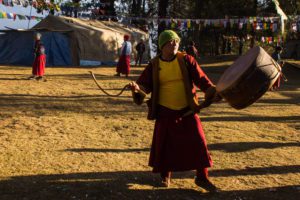
We left the scene as we realised we had to go collect our passes for the next day before office closes. With some Jalebis on the way to recharge us, we headed back down to the office and got our passes. Excited for the next day, we decided to use the remaining of the day to see the famed Sino-India War Memorial that we had passed on our way into Tawang. We took a cab all the way down to the military outpost it was located at. We were greeted by kind and unstinting Sikh gentlemen there. The monument was erected in honour of Indian soldiers who fought for the country in these treacherous terrains as we’d discover the next day. We paid our respects and headed to the gift shop. Managed and run by military, the shop was well stocked and very affordable. We bought loads of memorabilia for our families and friends. After spending a lot of time browsing we headed out as it was starting to get dark. While trying to hitch a ride we were informed of a light and sound show that was about to start and so we headed right back in. The night was cold and the show was amazing. With light play and sound effects the difficult history of the area and the troubled relations with China was communicated beautifully. The show ended with the national anthem that we sang our hearts out. Mist formed in front of our mouths as the lamps in the monastery on the hills twinkled as bright as the stars. A feeling of patriotism ran through our souls and we were extremely excited to go meet the brave army men working at the border posts the next day.
By the time we left it was too late to get a ride from anywhere, so up we walked! Slowly and silently through the dark night we walked through winding hill roads. For a long time all we could see were the stars above and the lights of the monastery far away. After trudging on for 20 minutes or so we met some kind souls who guided us with the way and we started seeing a few buildings around. We finally reached the town and fed ourselves heartily at the first open restaurant we could find. We headed further up to the main market and hotel, thoroughly worn-out and exhilarated after the long day. We got into our multiple layers of defence against cold for the night and it was lights-out! But as fate had it, it was supposed to be a long-long night.
The cold kept me shivering and sleep wouldn’t come easy. The multiple layers above me bound me to bed and it wasn’t the easiest task to even turn around in bed, let alone get up. Half-asleep, I said to Lakshmi how weirdly difficult it would be, say, if there’s an emergency like an earthquake to decide whether to stay in the blanket den or to brave the cold! My unnecessary remark at the end of the exhausting day was rewarded with a tut-tut and a comment to just close my eyes and to sleep from the other end of the room. I eventually did fall asleep but awoke with a swaying feeling. My head seemed to be going tipsy and I was sure these were hallucinations due to a temperature so low as I’d never experienced before. But the next thing I know Lakshmi’s awake next to me and fighting with her pile of blankets to escape the bed and then Atul on the other end of the room is standing and asking us to wake up! I was so sure I was dreaming that I wouldn’t react. I only did when someone started banging at the door! Lo-and-behold we are experiencing an actual earthquake and it’s the strongest one I have encountered! Slowly all of us struggled out of our sleeping bags and the shaking decreased. The guy from the reception came back to ask us to go back to sleep and we did not argue and snuggled right back in.
5th January, 2016
The morning was unusual as expected. We huddled together to enquire whether something really happened and fathom what actually did. Checking our phones we realised there had been a major earthquake in Manipur and what we felt in the night were immediate tremors. A lot of destruction had taken place in a place really close to us. We realised our proximity, and the game of fate. I was met with a “why’d you even say that, last night!” stare by Lakshmi. I was too ‘shaken’ to say much. We let our families know we were safe and then headed down to the market. People were all talking about it, but luckily the quake hadn’t caused any damage to structures around this area. We enquired about roads and access and were reassured as to the smooth flow of vehicles for now.
We walked to mud puddles frozen with ice and had a quiet breakfast and decided to head to Bum-la pass, now that we were so far from homes anyhow. We arranged for a vehicle, and soon we climbed into an Innova with our driver for the day, Meme. This was the first private vehicle we had booked for a long journey, it being the only way to access these remote areas. The frequency of people taking this trip is very low we were told, especially in the winter months, maybe 2-3 groups a week. We headed up, out of town with Meme. This was to be one long day!
The car went uphill in slow curves. We stopped at some check-posts where our permits were examined and we were met with quizzical stares (“Why here, in this cold? Why aren’t you in Goa?” they probably thought). Every few minutes the car would slow down and we’d pull down the windows to admire the mighty beauty of what was before us. A clear blue sky, the mountains making a silhouette of grey and fading away to more mountains below, the town of Tawang on one side and the Monastery looking over it on the other. It was awe-inspiring. As the car rolled up we started seeing patches of snow on the sides of the roads, the first we’d seen since Sela Pass. The road got narrower and riskier but the view only got better. There was hardly any greenery, just the occasional shrubs. The mountains were shades of grey and brown and there was a stoic beauty to it all. Soon we spotted at the day’s first frozen lake. The sight was intriguing. It was pitch white, this lake. It sat between those brown mountains. It was almost as if this was a computer wall paper, and somebody deleted the layer of the lake’s blue using Photoshop! We saw many of these lakes on the way as we went up and our ears popped. Meme promised he’d take us to one where we could walk on the ice. He drove on roads that wouldn’t be termed roads in any place but over there. There were instances when the road was covered with a layer of slippery ice and we were lucky to have someone as skilled as Meme to get us through. It was the most overwhelming car-ride we’d ever been to and we decided that no rollercoaster in the entire world could beat the rush we had on this trip. It’s a real hat off to the Border Roads Organisation to keep such extreme places accessible with their hard work. On the way we stopped at Sir Joginder Singh, a brave soldier’s memorial, covered with snow all around. We then drove on.
We finally reached Bum-La pass. We parked and found a Bengali family there. It was oddly soothing to find more visitors here (we weren’t the only crazy ones!). We were led into the small military settlement and received at the assembly hall with hot tea and warm smiles. The Army men at duty here stay in cold, remote locations like these for months together, away from home. They are cheery and welcoming to all visitors as they rarely get to meet people from different parts of India here. They gave us a short introduction about the location and Sino-Indian relations. They walked us to the gate at the end of the little military settlement. There was a heap of coloured rocks, titled as the Rocks of Peace. They told us how the border guards from both the countries get together on either country’s National Holidays and have a celebration right here at the border. They made us spot two rocks on top of two hills and draw in our minds an imaginary line. This is the border of India, LOC (line of control), they told us! Just like that! It was a sharp contrast to what we had seen a couple of years back at Wagah border with high barbed wires and armed gates. The relations of the men at the border outposts are amiable enough to let us walk ahead and cross over to China, stroll around and come back. Who knew that we’d get to visit a whole new country during the course of this trip? We took in the great views using army binoculars to spot Chinese outposts and an observatory and were then led back to the assembly hall. They had certificates ready for us. We are now the certified few to have visited the remote and exotic Bum-La pass between India and China in the Tawang district of Arunachal Pradesh!
We headed back to our car and Meme took us round risky mountainous roads again. We headed in a new direction now. We stopped over a military camp with a certain Café Rajputana. Every break we got from the stomach-churning car journey was welcome. We stepped off the car and were greeted by a littler of small little furry brown puppies. We walked into Café Rajputana, in the middle of nowhere, made out of green safari coloured tin sheets, and the environment inside was pleasant! A bunch of army men sat and drank tea and watched news on a television, there was a café stall offering tea, momos and pakoras. On another side was a stall selling military items like camouflage jackets, sleeping bags, boots, caps, gloves, sun glasses et al. We ordered ourselves some chai and momos and browsed at the stall as Atul bought a pair of Army boots for his father. The rest of decided to buy a pair of warm army socks as memorabilia. After snacking we hopped back into the car and moved on. Meme who had been in great terms with the soldiers around told us how he helps them by fetching parcels from the town frequently. Everyone was in a jolly mood now and Meme played songs from the 90s and early 2000s that reminded us of our childhood. It’s amazing how simple things like music bind people whose lives are so different to each other together. We were now headed to Tsangetsar Lake, commonly known as ‘Madhuri Lake’, after a popular song that was shot here, with Shahrukh Khan and Madhuri Dixit gyrating to Bollywood tunes. We had heard a sermon on the radio in the past days wherein they had appealed to the locals to use and appreciate the rich local names of locations and not lose their culture and history in lieu of modern lingo.
Tsangetsar Lake rested in a bowl formed in between the hills around, like a witch’s pot brew and we approached it spiralling from the top. It looked beautiful, frozen and surrounded by pine trees dotted with twinkling snow, right out of a fairy tale, like an icy oasis. We drove in with pretty trees covered in snow closing on the road from both sides and ‘tum toh tehere pardesi’ playing. Meme pulled into the parking and forbid us to try to step on the frozen lake, claiming it too risky. We got down hurriedly and headed towards the lake. There were colourful prayer flags strewn across, looking pretty against the striking white lake. We walked over wooden bridges across gurgling streams and reached the lake’s edge. The land here seemed to merge into a thick layer of ice on the lake but we dare not step on it. After a couple of us slipped in the mud we decided to retreat. Stepping slowly and carefully, taking in the view and the icy breeze and smell of pine trees and the faint chiming of bells. We found a snow edged path going around the lake and pursued it. When we found a cottony white, virgin looking mound of snow we couldn’t resist and jumped in. After a round of snow digging and throwing and playing and photographs we walked ahead. The path was beautiful and the lake looked amazing from all directions. We found a green patch overlooking the lake and down below a row of prayer flags to contemplate the scene. Atul found an empty beer bottle and we decided to check how thick the layer of ice on the lake could be. He hurled it across with full force at the lake and bounce- bounce- bounce it went and then just lied on top of the lake. We gawped in awe. We had walked a third of the way around the lake but decided to head back, lest our escort for the day start worrying. Also, hadn’t he promised us we could walk on something like this?
We got into the car and pestered him for it. We rode back and on the way we stopped at Nagula Lake. There was not a soul in sight. Meme certified it safe to be walked over and we ran down to the lake and braked right in time to not slip on the ice. The icy lake was covered with a layer of snow. We, initially with hesitance but eventually with stride walked around this frozen lake leaving our fat foot prints in the snow. The lake was surrounded by a low hill on 3 sides and it seemed like we were the first people in weeks to be walking around here. We took in the view and then tip toed back to land and thanked Meme for the great experience of the whole day. We went back down to Tawang, there were many more great views, curvy bends to the road and 90s Bollywood music for the way.
We reached the market when it was still early, and so the place was in full activity. We all bought prayer flags for our rooms and chatted with the locals who told us much about the place the changes, good and bad, that the recent developments have had. We strolled, had some Chow and juice at Woodbox café from where we could see the sun set behind the Tawang Monastery. As it grew darker, we discussed how unbelievable these past few days had been, how so much happened in such little time and how it seems like months since we’d been giving our construction submissions in Delhi. We walked around town a little, debated staying another day but decided against it, considering the long distances to be travelled. We had dinner and called it a night, tucking in for one last time inside our 5 layers of winter armour.
6th January, 2016
It was a very early morning that started with a light breakfast of bread and coffee/chai. We were to go spiralling down a lot of hills in one vehicle in one go today, to leave the lovely Arunachal and reach Tezpur by night. We got into the shared Sumo that we’d bought tickets for and got ready for it. The driver kept picking people up on the way, until the car could heaved painfully, and then some more. By the time we were leaving town the car had more than a dozen people packed in. It had gotten especially cold the previous night and once we were out of town, we could see the effects. All the shrubs and small trees on the edges of the road were covered with what appeared to be snow crystals. They glistened in the sunlight with such glory. Howsoever over-packed our car was, we seemed to be driving through a dreamy Christmas land of magic. There was long stretch of road where we rode through thick clouds. If only we been in a private vehicle, or the driver of this one friendlier we could’ve made him stop and take it all in. But we took what we got. The ride went on for a long time with us crossing all the towns we had come through earlier. We stopped at a small stall for a light lunch. Most of the day was daze and a struggle to find elbow and knee space in the vehicle, and staring out the window at the mountains we were leaving.
We crossed the lovely Bomdila and smiled with fondness. By evening we had reached back to Bhalukpong and the driver took a break. Yogesh grabbed this opportunity to run back to the shop he’d spotted and buy the little cane stool he had an eye on. He came back to the car overjoyed with his little prize. By 8:30 in the night we reached the dusty little town of Tezpur in Assam. Somewhere on the way we said our final goodbyes to mountains, nature, wilderness, raw beauty and kindness. At the bustling transport hub of Tezpur we were treated with honking, swearing, smoke and chaos. But for once in a long time, a town wasn’t asleep when we arrived. We walked along the dirty street we’d been dropped at trying to look for a place for the night. After much hassle we settled for a certain Hotel Durba, not the classiest or cleanest, and somewhat creepy. Our guidebooks and internet failed us with Tezpur and we were too drained from the journey of the day to find another place. We checked into our two rooms and dumped our luggage and went hunting for food. With no viable option in sight, we decided to go to the Domino’s we’d spotted on the way into town. There, we hogged on junk food like our lives depended on it. It was good to be out just wearing one layer of clothing instead of our standard 3 since a week. Tezpur didn’t seem like it had much to offer so we ate, went back to our hotel, took our much needed baths and locked our rooms to retire for the night.
7th January, 2016
We woke up at ease, the day started late with a heavy breakfast ordered to the room and a movie about a crocodile swamp on television. We ate slowly, packed slowly and then walked out onto the chaotic mess of a street. We found our way to the bus stop by noon and were on the first bus to Guwahati we could find. The ride was spent listening to music, chatting and looking out the window at Assamese villages. We reached Guwahati late in the evening, crossing the Brahmaputra to enter the bustling city. We changed busses to reach the familiar Paltan Bazaar. We checked into the same hotel and room as before. We dumped our luggage again and started to freshen up when Atul realised he had lost his debit card. He unpacked all the myriad contents of his pockets on the bed and ran back out to search for it before we could stop him. Slowly we three left the hotel and tried to look for his card around the areas we’d walked. With no luck, and severe hunger we walked into KFC again and ordered the standard junk again. Suddenly, it seemed ages ago that we had been throwing stones into the river near Tipi or walking under the stars in Tawang or picking out fire wood for Tem Ering! Such are journeys. Eventually, Atul found us slumped in a corner table in KFC and we bought him a meal. We discussed our plans for heading back and off to work but the conversation was dry. We headed back to our rooms and watched television and slept.
8th January, 2016
Wrapping up our journey just as we had started, we packed up, grabbed our bags and checked out of our room. We had breakfast at the same place we had it 10 days ago. Then, us with our overloaded backpacks, dirty pyjamas and messy hair, walked through the extremely crowded railway station. At noon that day we caught our train to Delhi. We saw Bengal, Jharkhand and UP whizz by and then pulled into Delhi on the 10th of Jan.
I read somewhere that happiness can only be found in anticipation and in memory. I cannot say I completely agree, but I get where this comes from. The trip to Arunachal Pradesh was exhilarating. I experienced things I wouldn’t have imagined in my wildest dreams to have. I experienced cold like I never thought was possible. I met people kind and generous like I never thought strangers could be. I saw sights so grand and traversed distances so wide that they would weary the most experienced of travellers. And the trip had all its moments, highs and lows and so many in between. What made it even more special was the months we spent scheming and planning. Those hunts for a map, choosing the right places, acquiring permits and hours spent discussing possibilities. Then there were memories, sharing all the stories with each other and our families, the expression of confused disgust on my mother’s face when I showed her the squirrel’s tail that Tem Ering gifted to me and her pleasure at pretty golden dragons on the china bowls. I’ve had the greatest time sharing our stories with other friends and what makes it all the more special is that I got to share this experience with the best of the people I’ve ever known, always up for an adventure. I look back to the night we’d sat with a map of India and pointed out to the farthest North-eastest corner of the country and decided “Yahaan Jaana Hai!” and I still can’t believe it actually happened.
We are more than grateful to the Xtreme G2 team for giving us the opportunity to dream big and for help in making those dreams take shape. It is a great opportunity for students to discover new lands, new people, and new realities and to share them with everyone else. A deep and heartfelt thanks to you.
